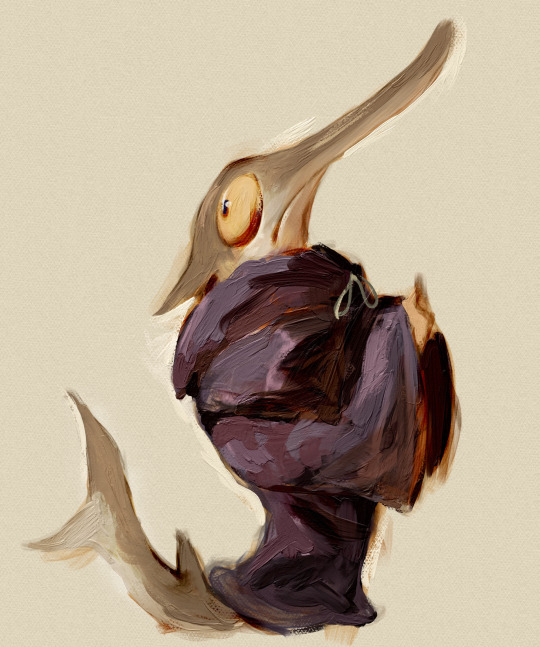#Paddlefish
Text
At a previous job (removing invasive carp from the Mississippi river) we would get lots of bycatch. While most native species could just be tossed back in the water and do just fine, paddlefish are a lot more Fragile and really don't do good when out of the water. To help them, we would pull them through the water to force it over their gills and give them a jump start. The best place to grab them is by the rostrum. It's all very scientific, but I couldn't help but feel funny grabbing these goobers by the schnozz taking them for a ride

22K notes
·
View notes
Text

sturgeon and paddlefish for a commission!!
5K notes
·
View notes
Text
Do you ever just think about sturddlefish? I do

#Sturddlefish#Sturgeon#Paddlefish#Fish#Today I bring you this. Tomorrow? Who knows#How tf do you tag stuff so people will actually see it#Chordata#Actinopterygii#Acipenseriformes#Acipenseridae#Polyodontidae#Silly#Not a reblog#Aquatic
1K notes
·
View notes
Text
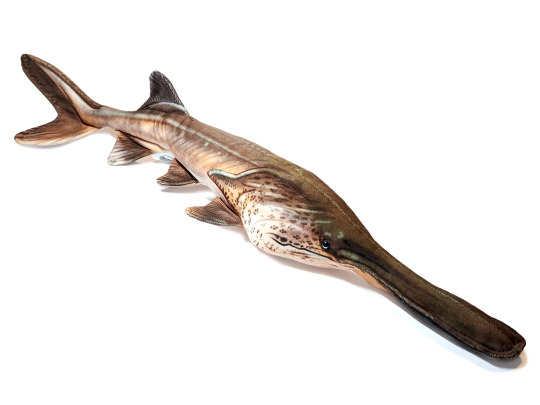
American Paddlefish!! New plush!
I'll try and keep them away from my sturgeons but... honestly a Sturddlefish might be a cool plush to make!
You can find 'em for sale over here; https://www.palaeoplushies.com/shop/paddlefish
367 notes
·
View notes
Text

The pixel artist Neorice (https://twitter.com/Neoriceisgood) is making an enormous collection of pixel art marine creatures. I sent him an email asking if I could upload some of his art to my blog and he said I could; so here are a few of my favourites. I might update this post if there are new ones I'm quite fond of.
#pixel art#fish#eel#cephalopod#giant squid#barreleye fish#sturgeon#alligator gar#hagfish#anglerfish#coelacanth#porpoise#paddlefish
353 notes
·
View notes
Text
Angling in Teyvat: a Glimpse into Aquatic Life across the Continent

From the vast freshwater rivers of Sumeru to the dark depths of Inazuma, aquatic life is diverse and widespread in Teyvat. Some that are common and widely available in fish markets and ponds, and others that only a handful of people have even seen alive in their natural habitat.
Hope you liked this mini series, I might make more if y'all want it :>
#art#illustration#speculative evolution#clip studio paint#fanart#genshin impact#fish#fishing#bass#marlin#axolotl#guppy#pufferfish#pike#paddlefish#angelfish
512 notes
·
View notes
Text
Daily fish fact #533
Chinese paddlefish!

It was one of the two recently still extant species of paddlefish, until it was declared extinct in 2022, of course. They were native to the Yangtze River basin, living their adult lives near the coast and migrating up rivers to spawn. The other current species of paddlefish is still extant.
#it was thought to have gone extinct already in the mid 2000’s though#fish#fishfact#fish facts#fishblr#biology#zoology#paddlefish#chinese paddlefish
591 notes
·
View notes
Text

302 notes
·
View notes
Note
Do you have any cool facts about Missouri wildlife?
I'd love to share something with my Midwestern friends, and thank you for always updating this blog!
I don't know if i have any Missouri animal facts per se... but I can share some of the state symbols with everyone.
We moved around a lot when we first came to the U.S. and we lived briefly in Kansas City. I have great memories of going to the Ozarks at Christmas time (near Lake of the Ozarks). I specifically remember following woodpeckers and deer around the forest in the snow.
SOME MISSOURI STATE SYMBOLS:
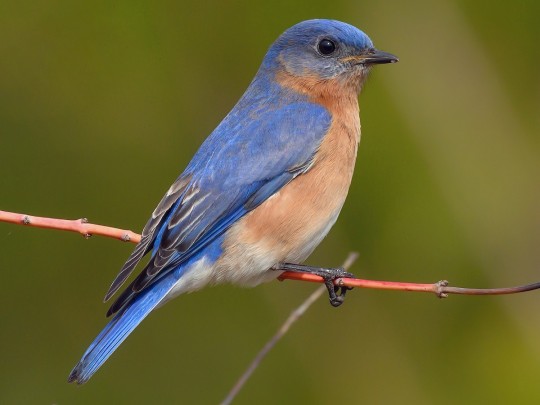
STATE BIRD: Eastern Bluebird (Sialia sialis), family Turdidae, order Passeriformes, found across much of the central and Eastern U.S., SE Canada, and NW Mexico
Changes in land use lead to drastic declines in Eastern Bluebirds after the early 1900s. They have recovered in many places, due to "bluebird trails", reestablishing appropriate habitat and nest box campaigns for public and private property.
Find out more: NestWatch | Eastern Bluebird - NestWatch
Blue birds are in the thrush family, Turdidae, along with American Robins.
They eat mainly worms, insects, and other small invertebrates (but also take berries for part of the year).
Bluebirds are cavity nesters, nesting in tree holes usually, but will readily take to properly constructed and placed nest boxes.
Males (pictured) are brighter blue, and females are a more muted and faded blue or bluish gray.
photograph by Keith Kennedy

STATE AQUATIC ANIMAL: American Paddlefish (Polyodon spathula), family Polyodontidae, order Acipenseriformes, found in various parts of the Mississippi River basin
This species is the only member of this family that still exists. They are most closely related to sturgeons. This order, Acipenseriformes, is considered one of the most evolutionarily primitive groups of ray finned fishes.
They do not have scales, and their skeleton is mostly cartilaginous.
They are filter feeders. Their heads and rostrums are covered with thousands of sensory receptors, which help them locate zooplankton swarms.
They are considered "vulnerable" due to overfishing, habitat degradation and destruction, and pollution.
photograph via: US Fish & Wildlife Service
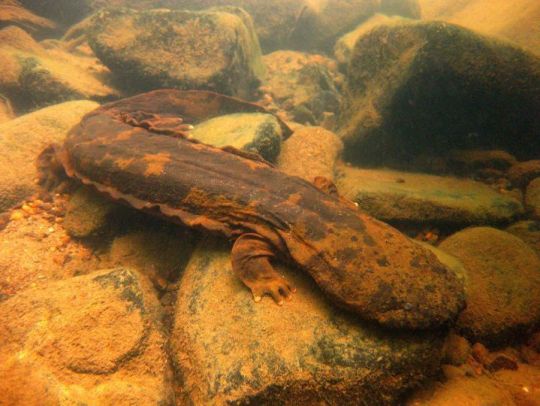
STATE ENDANGERED ANIMAL: Eastern Hellbender (Cryptobranchus alleganiensis), family Cryptobranchidae, eastern United States
The largest salamander in the Americas, it grows to a total maximum length of up to 40 cm (15.7 in).
Though nationally it is considered to be just "vulnerable", in some states (like Missouri), it is "endangered".
photograph by Mark Tegges

STATE REPTILE: Three-toed Box Turtle (Terrapene triunguis), family Emydidae, found in the South-central and Southeastern U.S.
This specie shas been considered to be a subspecies of the Eastern Box Turtle, T. carolina (and still is by some herpetologists).
These turtles are terrestrial, but are not closely related to tortoises. They are in the same family as aquatic sliders, pond turtles, cooters, map turtles, and painted turtles.
photograph by Noppadol Paothong
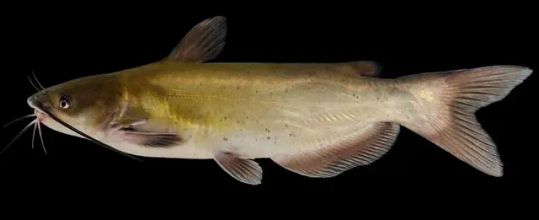
STATE FISH: Channel Catfish (Ictalurus punctatus), family Ictaluridae, order Siluriformes, found in freshwater habitats in the eastern and southern US, southern Canada, and northern Mexico
They are widely caught, and have been introduced into waterways in other parts of North America and around the world. (In some places they are considered an invasive species).
photograph via: Missouri Dept. of Conservation

photograph by Brian.gratwicke
#Acipenseriformes#paddlefish#fish#ichthyology#box turtle turtle reptile#herpetology#bluebird#thrush#bird#ornithology#north america#hellbender#salamander#amphibian#animals#nature#catfish
177 notes
·
View notes
Text

daily painting - 03/09/2024
American Paddlefish
100 notes
·
View notes
Text
Easily my most popular post was about paddlefish, so this Wet Beast Wednesday it's time to give them their moment in the sun. Paddlefish are members of the family Polyodontidae and one of only two surviving members of the order Acipenseriformes, the other being sturgeons. The Acipenseriformes are one of the oldest lineages of ray-finned fish and diverged from the ancestors of all other modern ray-finned fish around 300 millions years ago. While paddlefish have been around since the Cretaceous period, there is only one living species, the American paddlefish (Polyodon spathula). Another modern species is the Chinese paddlefish (Psephurus gladius), but the last sighting of one was in 2003 and they were officially declared extinct in 2022. In this post, unless I specify otherwise everything I say will be referring to the American paddlefish.

(image: either an American paddlefish or a basking shark that got its nose caught in a hydraulic press)
Paddlefish are named for their very long rostrums which are packed full of electrorecepting organs called the ampullae of Lorenzini used to sense electric fiends in the water. The ampullae are not only on the rostrum, but also on the head and large skin flaps that extend from the operculum (gill cover). They are so sensitive that paddlefish are able to sense the movement of individual body parts of zooplankton. Paddlefish use their rostrums to detect their prey, which consists almost entirely of zooplankton. They are ream suspension feeders, swimming toward swarms of zooplankton with their mouths open. As the water passes through the gills, gill rakers filter out the zooplankton, which is then swallowed. Other fish that use this feeding method include basking sharks. While the rostrum is the primary method of prey detection, other ampullae on the head and operculum flap allow the fish to still effectively find food even if the rostrum is damaged or destroyed. When working fish fish on the Mississippi I caught multiple paddlefish who lost their rostrums to propeller strikes and were still doing fine. Electroreception is their main sense, with their eyesight being extremely poor.

(image: the skeletal structure of the rostrum)
As chordates, paddlefish have a notochord that runs from the head down the body. In most modern chordates, the notochord is only present in the embryo and is lost during development. This is not the case for paddlefish, who retain their notochord into adulthood, where is acts as a soft spine. While paddlefish (and their sturgeon cousins) are bony fish, they have lost most of the bone and now have skeletons composed almost entirely of cartilage. It is for this reason that early taxonomists initially miscategorized paddlefish as freshwater sharks. To be fair, they do look a lot like miniature basking sharks. Who crossbred with spoons. They also lost their scales and have smooth, easily damaged skin instead. Their skin is so easily damaged that just being caught in nets can leave scars. Paddlefish are large and long-lived. The American species reaches an average of 1.5 m (5 ft) in length, with the rostrum making up a third of that, and a weight of 27 kg (60 lbs). The largest recorded specimen was 2.16 m (7 ft 1 in) and an estimated 90 kg (198 lbs). Despite being one of the largest American freshwater fish, they paled in comparison to the Chinese species, which could reach 3 m (9.8 ft) and 500 kg (1,100 lbs). The largest Chinese paddlefish on record was 7 m (23 ft) long and was estimated to weigh "a few thousand pounds". The Chinese paddlefish also preferred larger prey, feeding largely on small fish and crustaceans. American paddlefish live an average of 5 to 8 years, but in the right circumstances can live up to 60 years, with females generally living longer. The Chinese paddlefish had an estimated average lifespan of 29-38 years. In both species, it is believed that human activity drastically reduced their average lifespans.
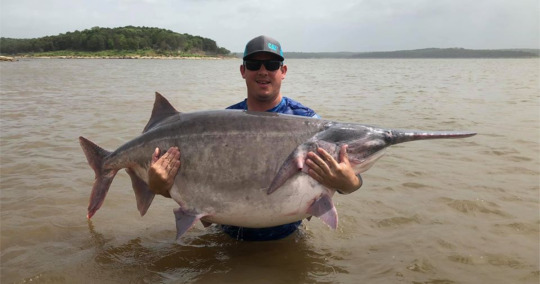
(image: an absolute unit of an American paddlefish)
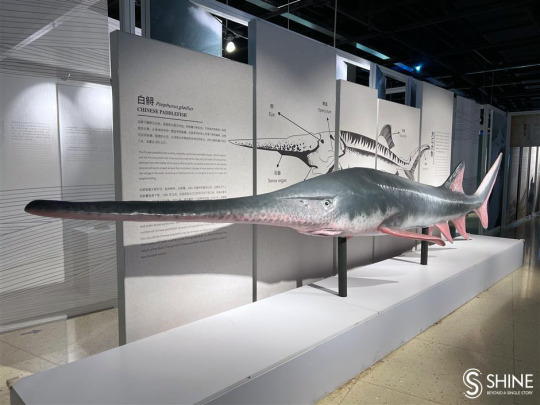
(image: a reconstruction of a Chinese paddlefish from the Shanghai Science and Technology Museum)
Paddlefish travel upriver to spawn in spring. They prefer to span on shallow gravel bars that would be exposed to air if not for spring rainfall and snow melt. Because they require very specific conditions to spawn, spawning rarely occurs every year. Every 4-5 years is more common. Paddlefish are broadcast spawners, with both males and females releasing gametes into the water column. Fertilized eggs are negatively buoyant and sticky. They will sink to the bottom and stick to the gravel. Once hatched, larvae will be swept down river to develop in deep pools. They are born without rostrums, which start to grow almost immediately. Paddlefish mature late, with females becoming sexually mature between 7 and 10 years of age, with a few not maturing until as late as 16-18 years. Human activity is resulting in many individuals dying before becoming sexually mature. American paddlefish are cross-fertile with the Russian sturgeon (Acipenser gueldenstaedtii), producing a hybrid offspring known as the sturddlefish despite being separated by the Atlantic ocean and 184 million years of evolution. This was discovered by accident when scientists introduced paddlefish sperm too sturgeon eggs as a control group for an experiment. I made a post on the sturddlefish which you can read here.

(image: three larval paddlefish of different ages)
American paddlefish are classified as vulnerable by the IUCN. They are native to the Mississippi river basin that encompasses much of the midwest and south of the United States, but their range used to be larger, reaching into Lake Huron, the Northeastern U.S. and parts of Canada. This reduction of native range is due largely to human activity, mostly overfishing and habitat loss. Zebra mussels, an invasive species, are a major competition for paddlefish as theybith feed on zooplankton. Reintroduction programs have begun in some of the states they were extirpated from, and they have been introduced to China, Cuba, and multiple countries in Europe for use in fishing and caviar production. 13 states allow for sport fishing of paddlefish, some of them relying on restocking to maintain a population for anglers. Paddlefish meat is edible and their eggs can be used for caviar. Paddlefish can be raised in captivity, but must will not spawn in captivity and so establishing captive populations requires gonad extraction and artificial insemination. Poaching of wild paddlefish for their eggs is an ongoing problem. The extinction of the Chinese paddlefish is believed to be the result of overexploitation and habitat loss.
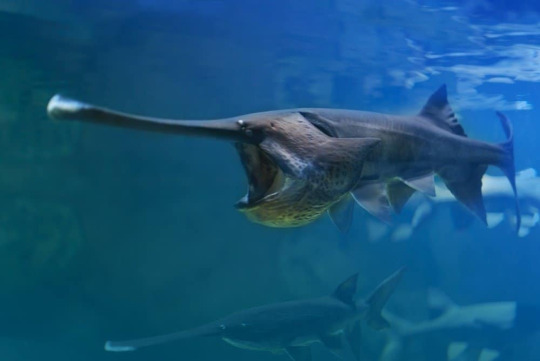
(image: a paddlefish with its mouth open)
#wet beast wednesday#biology#zoology#fish#ecology#fishblr#freshwater biology#freshwater fish#aquatic biology#paddlefish#american paddlefish#chinese paddlefish#animal facts
518 notes
·
View notes
Text
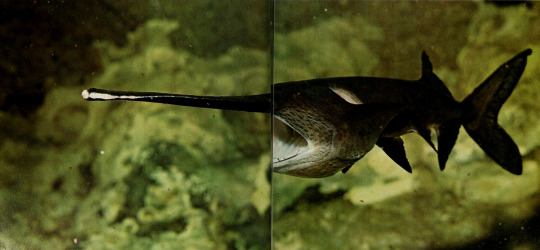
Paddlefish
By: Russe Kinne
From: Natural History Magazine
1977
128 notes
·
View notes
Text

fish friends (not to scale)
62 notes
·
View notes
Text

microscopic image of larval paddlefish
26 notes
·
View notes
Text

Just been out here filter-feeding since the Cretaceous...
American Paddlefish (Polyodon spathula)
Mississippi River basin, USA
Status: Vulnerable
Threats: overfishing, pollution, habitat destruction, poaching for caviar
----
Having some bad days, I will post when I can. 👍🏼
15 notes
·
View notes
